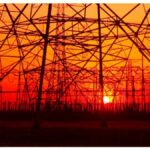Energy News Beat
U.S. electric load is growing significantly faster than grid planners previously expected, led by new manufacturing and industry and the growth of data centers, according to a Tuesday report from Grid Strategies. Electrification, hydrogen production and severe weather are also contributing.
Reports filed this year with the Federal Energy Regulatory Commission show grid planners expect nationwide electricity demand to grow 4.7 % over the next five years — while 2022 estimates called for just 2.6% growth. Peak demand is expected to grow 38 GW over the next five years.
The electric grid “is not prepared for significant load growth,” the report concludes. “Low transfer capability between regions is a key risk for reliability if load growth outpaces deployment of new generation in some regions.”
Electric load growth in the U.S. has been anemic for years, but that may be about to change.
The report, “The Era of Flat Power Demand is Over,” is likely the first nationwide compilation of utility load forecasts, Grid Strategies President Rob Gramlich said in an email. The report starkly illustrates the electric sector challenges ahead.
“The low and falling levels of load growth for the last 20 years have decisively reversed to a new mode,” Gramlich said. “This is important for a number of reasons, not the least of which is that grid infrastructure is not prepared. Industry grid planners and government policy makers will likely need to accelerate their planning, permitting, and other actions necessary to getting transmission built.”
Data for the analysis comes primarily from FERC Form 714, which is an annual planning report submitted by electric balancing authorities across the 50 states and the District of Columbia.
At the heart of the near-term load growth is a roughly $630 billion investment in facilities that have large loads, including $481 billion for manufacturing and industrial facilities and $150 billion for data centers, according to the report. Efforts to revive domestic manufacturing, including the CHIPS and and Science Act, “appear to be having an effect,” Gramlich said. Growing interest in artificial intelligence is also increasing the power needs of data centers.
And since filing their 2023 load forecasts with FERC, Grid Strategies said some major utilities “have further increased near-term electricity demand forecasts.”
“It is too early to say whether load will grow at 1% per year, 3%, or higher, but it is clear that there are new drivers of growth that appear to be here to stay,” Gramlich said. The electrification of transportation and buildings, investments in hydrogen production, and more severe weather, will also drive demand higher, he said.
The U.S. grid is not ready for all of this new demand, the report warns, and a slowdown in transmission investment could lead to overspending on generation.
Installation of new high voltage transmission lines can alleviate grid stress and enable new clean energy resources, but the number of miles constructed each year dropped from about 1,700 from 2010 to 2015, to about 645 in the second half of the decade, Grid Strategies said.
If load growth is met through the development of “new, nearby generation” the report warns this could result in capital investments of billions of dollars per gigawatt of new load.
“A more valuable and less costly approach to ensuring reliability is ensure the same reliability with increased transmission capacity to transfer power from one region to another,” Grid Strategies concluded. “Capacity delivered through inter-regional transmission is likely to cost less than $300 million per GW of new load.”
The report is “shocking,” Simon Mahan, executive director of the Southern Renewable Energy Association, said on X, formerly known as Twitter. The Southeast is experiencing “huge growth across all sectors.”
The rapid load growth highlights some “irony” in the tension between generators and loads, Mahan added.
“In the near term, this load growth may lead utilities to add more fossil generation or delay retirement plans. But, much of the new load growth is demanding clean, zero carbon energy,” he said. “There’s got to be a good mix, or utilities will be building [combustion turbines] to nowhere.”
The post US electricity load growth forecast jumps 81% led by data centers, industry: Grid Strategies appeared first on Energy News Beat.








